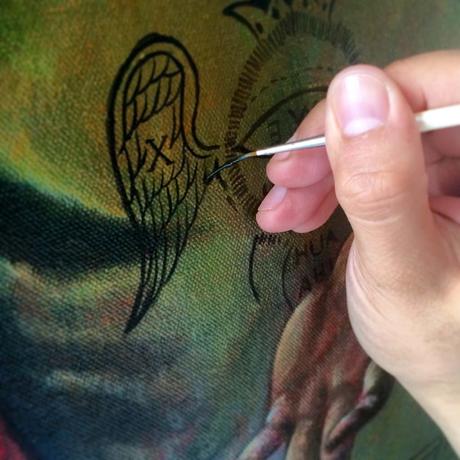“Masasabi na ang Infinito Dios o ang Nuno (katutubong Bathala ng mga Tagalog) ay ang henyo o galing ng mga Pilipino na napasok sa bato o anting-anting, na kailan man ay hindi nakapamulaklak at nakapanaig dahil sa kahirapan at kawalan ng kapangyarihan.”
– Nenita Pambid, “Anting-Anting: O Kung Bakit Nagtatago sa Loob ng Bato si Bathala”
I grew up listening to stories about anting-antings, sacred amulets that gave the wearer powers and protection. In movies, the actor Ramon Revilla popularized the idea of the anting-anting. I saw the old Ramon Revilla flicks on afternoon TV after coming home from school. There was Nardong Putik, the hoodlum turned folk hero in Revilla’s movies who became invisible when in contact with mud. I remember Kapitan Inggo, Kumakain ng Bala who made snacks of bullets. There were stories that you had to stand underneath a banana blossom (puso ng saging) at night while waiting for it open and eject a droplet of magical juice. The supplicant must catch the droplet in the mouth to receive magical powers.


My grandmother gave me a rosary and told me to keep it close like a sacred amulet. She had an old prayer book bound in black cloth, pages yellowed and smelling of age. And I imagined it to be an object of power, like an ancient book of spells. I took it to school and kept it in my pocket and I imagined it had magic.

In Quiapo, vendors sell amulets beside the Catholic Church. Supplicants touch the statues of saints with their handkerchiefs and rub it on their bodies as a kind of benediction.

The Filipino revolutionary Macario Sakay famously wore a vest with inscriptions as an anting-anting to ward of danger and harm. It didn’t work though; he was hanged by the Americans.

The idea of magical talismans permeates Filipino popular culture, even in our superheroes. Whereas, American superheroes were born out of science experiments, many Filipino superheroes possess magical objects that grant them powers. The superheroine Darna, who in her civilian guise is a crippled girl named Narda, accesses her powers by swallowing a rock that fell out of the sky. Then there’s Captain Barbell who transforms from his scrawny alter ego by lifting a magic barbell.


In the mythological landscape of the Philippines, it seems you can possess God through objects.

While preparing for my painting “Bathala sa Bato” (24 x 48 in., Acrylic on Canvas), I turned to Nenita Pambid’s book “Anting-Anting: O Kung Bakit Nagtatago sa Loob ng Bato si Bathala”

Scholarly research into anting-antings can be difficult to find. That’s why Pambid’s book is a gem.

Although it could have greatly benefitted from better production values and colored photos, it remains an interesting glimpse into the world of these mysterious amulets.
